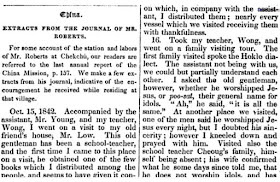The above is excerpted from The Baptist Missionary Magazine, vol 23, p 278, 1843, part of the journal of Rev Roberts who was then preaching in Hongkong
"16. Took my teacher, Wong, and went on a family visiting tour. The first family visited spoke the
Hoklo dialect. The assistant not being with us, we could but partially understand each other..."
And in the next paragraph: "At a later hour, in company
with the assistant, Mr. Young, and Wong, my teacher, visited Titam
village, and a family there, who speak the
Hoklo dialect; which is nearly the same as Tiéchiú, which the assistant speaks."
These appear the first mentions of Hoklo in the Western literature. Tiéchiú = 潮州話, which is indeed another form of Hoklo.
The entire volume can be found in Google Books here:
https://play.google.com/books/reader?id=4gHPAAAAMAAJ&printsec=frontcover&output=reader&authuser=0&hl=en&pg=GBS.PP1
Hoklo [河洛話], officially the Min-Nan [閩南語], is the primary language of most Taiwanese. 閩南 refers to Southern Fujian where the ancestors of most Taiwanese migrated from. The term Min-Nan has been used as a reminder of its Chinese origin. Outside of Taiwan, Hoklo is also known as Hokkien [福建話], spoken by 華人 (residents of Chinese origin) predominantly in the Philippines and SE Asia that includes Singapore, Malaysia, and Indonesia.
A language becomes extinct only because of disuse and replacement, e.g., the Manchurian language, or simply because no one is left to speak it. There is a long list of dead languages, none through banning by decree, however. The latter has been tried in Taiwan, most recently in 1946. Today, Taiwanese speak not only Hoklo but also Taiwanized Mandarin Chinese, or 台灣國語, that borrows liberally from Pekingese and other dialects from China, English, and Japanese.


